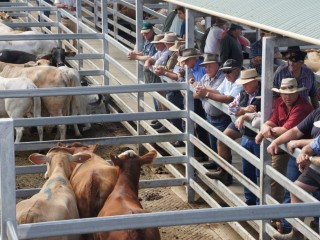 Cattle prices have risen in response to tighter supplies this week, with the Eastern Young Cattle Indicator recovering most of the ground lost since Easter to climb within sight of 400c/kg.
Cattle prices have risen in response to tighter supplies this week, with the Eastern Young Cattle Indicator recovering most of the ground lost since Easter to climb within sight of 400c/kg.
Interruptions to cattle movements caused by wet weather in Southern Queensland, NSW and Victoria and a tendency by producers carrying grass to withhold cattle from sale at current prices have contributed to another week of short supplies.
National cattle saleyards throughput was 34 percent lower than the same time last year, according to Meat and Livestock Australia’s National Livestock Reporting Service.
The greatest supply of grown cattle is coming out of Queensland’s south and central west, but even there supplies are not flooding the market.
Grant Daniel Long director and livestock manager, Peter Daniel, said that after a short rush of supply following the short killing weeks around Easter, numbers had again dried up.
“A fair few moved in the north when it dried out, but we’re not swamped with numbers,” Mr Daniel said.
“There are still cattle to come, but I don’t see there being a big flood of fat cattle.”
Of the numbers that were coming through, Dalby was seeing very good quality bullocks and cows from Hungerford in Queensland’s far south west, a consistently strong supply area for the Dalby yards.
A run of bullocks from a south-western Queensland station has been selling at Roma over the past three weeks, cattle that were initially earmarked for market in October/November last year but delayed by six months of wet weather.
Victorian processor Ralph and Wagstaff joined the regular panel of buyers in the laneways of Dalby on Wednesday and Roma on Thursday to bid on finished cattle, an indication of how far some processors are travelling to find adequate numbers.
Elders Roma manager James Croft said it was the first time in 12 months that processors from as far south as Victoria had operated at Roma.
A buyer for one southern Queensland processor said the presence of Victorian processors in Queensland was a sign of how hard it was proving to source required numbers.
“I think cattle numbers are just very low and it is an ongoing problem,” he said. “Most processors from here south are short on numbers.
“There is plenty of competition around, it is not easy to maintain your share of cattle that is for sure.”
In the store market, Elders’ James Croft said that while competition from restockers was very strong for weaners, a gap in demand had emerged for feeder heifers and steers. Cattle in that category had dropped by 15-20c/kg in the past three to four weeks, he said.
The Eastern Young Cattle Indicator closed on Thursday at 396.25c/kg, 8c higher than one week ago.
The trade steer indicator was 5c higher on 208c, while feeder steers gained 5c to 210c/kg. Japan ox was 4c higher on 178c after last week’s losses and medium cows were 2c higher on 137c/kg according to MLA.
